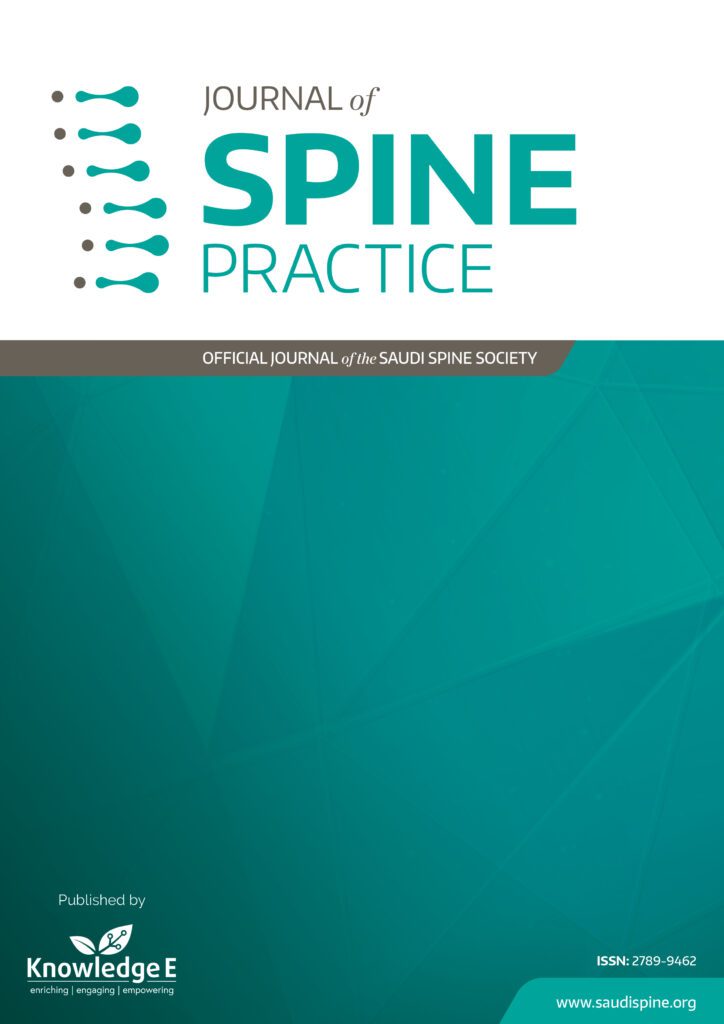
Journal of Spine Practice
ISSN: 2789-9462
Leading research in all spine subspecialties focusing on orthopaedic spine, neurosurgery, radiology, and pain management.
Correlation of Lumbar Spine Fat Thickness and Surgical Site Infection in Degenerative Lumbar Spine Surgery
Published date: Nov 20 2023
Journal Title: Journal of Spine Practice
Issue title: Journal of Spine Practice (JSP): Volume 3, Issue 1
Pages: 7 - 14
Authors:
Abstract:
Introduction: Surgical site infection (SSI) is a serious and common complication following any surgery. Patientsundergoing lumbar surgery have a higher risk for SSI. Therefore, it is essential to accurately identifythe risk factors of SSIs to prevent them. There is an insufficient number of studies internationally andonly one to our knowledge nationally that studied the correlation between lumbar fat thickness andSSI in patients undergoing lumbar spine surgery. Our aim was to identify the correlation betweenlumbar fat thickness and SSI and determine its predictive value compared to other risk factors inpredicting the incidence of SSI.
Methods: This retrospective cohort study involved all patients aged 18 and above who underwent primary elective degenerative lumbar spine surgery in National Guard Health Affairs (NGHA) from 2016 to 2020 at King Abdulaziz Medical City (KAMC), Riyadh, Saudi Arabia. All trauma and oncology cases, patients with previous spine surgery, non-instrumented cases, and emergency cases without preoperative radiological images were excluded. The pre-operative and post-operative measurements were assessed using the sagittal MRI images on the T1 view to measure the fat length of the lumbar spine from L2 to S1. Two observers evaluated the films, and the average measurement was documented for each level.
Results: 151 patients were included in our study, four of whom developed SSI. When comparing the demographics of both groups, BMI was found to be a significant variable between both groups, with a P-value of 0.013. However, there was no significance regarding age, gender, DM, HTN, steroid use, and level of stay for each group. Furthermore, there was no significance in all vertebrae levels except for L4 fat thickness, which was significantly higher in the SSI group with a P value of 0.0264.
Conclusion: Surgical site infection (SSI) is a serious and common complication following any surgical operation. Patients undergoing lumbar surgery have a higher risk for SSI. In this study, we concluded that an increased L4 fat thickness was a significant predictor of SSI.
Keywords: Lumbar fat thickness, Surgical site infection, Lumbar surgery, MRI fat thickness
References:
[1] Whitehouse JD, Friedman ND, Kirkland KB, Richardson WJ, Sexton DJ. The impact of surgical-site infections following orthopedic surgery at a community hospital and a university hospital: adverse quality of life, excess length of stay, and extra cost. Infect Control Hosp Epidemiol. 2002 Apr;23(4):183–9.
[2] Blumberg TJ, Woelber E, Bellabarba C, Bransford R, Spina N. Predictors of increased cost and length of stay in the treatment of postoperative spine surgical site infection. Spine J. 2018 Feb;18(2):300-306. doi: 10.1016/j.spinee.2017.07.173. Epub 2017 Jul 21. PMID: 28739477.
[3] Gupta VK, Zhou Y, Manson JF, Watt JP. Radiographic spine adipose index: an independent risk factor for deep surgical site infection after posterior instrumented lumbar fusion. Spine J. 2021 Oct;21(10):1711–7.
[4] Blood AG, Sandoval MF, Burger E, Halverson-Carpenter K. Risk and Protective Factors Associated with Surgical Infections among Spine Patients. Surg Infect (Larchmt). 2017 Apr;18(3):234-249.
[5] Zhang L, Li EN. Risk factors for surgical site infection following lumbar spinal surgery: a meta-analysis. Ther Clin Risk Manag. 2018 Oct;14:2161–9.
[6] Mehta AI, Babu R, Karikari IO, Grunch B, Agarwal VJ, Owens TR, et al. 2012 Young Investigator Award winner: the distribution of body mass as a significant risk factor for lumbar spinal fusion postoperative infections. Spine. 2012 Sep;37(19):1652–6.
[7] Yao R, Zhou H, Choma TJ, Kwon BK, Street J. Surgical Site Infection in Spine Surgery: Who Is at Risk? Global Spine J. 2018 Dec;8(4 Suppl):5S–30S.
[8] Wimmer C, Gluch H, Franzreb M, Ogon M. Predisposing factors for infection in spine surgery: a survey of 850 spinal procedures. J Spinal Disord. 1998 Apr;11(2):124–8.
[9] Koutsoumbelis S, Hughes AP, Girardi FP, Cammisa FP Jr, Finerty EA, Nguyen JT, et al. Risk factors for postoperative infection following posterior lumbar instrumented arthrodesis. J Bone Joint Surg Am. 2011 Sep;93(17):1627–33.
[10] Lee JJ, Odeh KI, Holcombe SA, Patel RD, Wang SC, Goulet JA, et al. Fat Thickness as a Risk Factor for Infection in Lumbar Spine Surgery. Orthopedics. 2016 Nov;39(6):e1124–8.
[11] Salazar JJ, Ennis WJ, Koh TJ. Diabetes medications: Impact on inflammation and wound healing. J Diabetes Complications. 2016 May-Jun;30(4):746-52.
[12] 12. Ogihara S, Yamazaki T, Shiibashi M, Chikuda H, Maruyama T, Miyoshi K, Inanami H, Oshima Y, Azuma S, Kawamura N, Yamakawa K, Hara N, Morii J, Okazaki R, Takeshita Y, Tanaka S, Saita K. Risk factors for deep surgical site infection following posterior instrumented fusion for degenerative diseases in the thoracic and/or lumbar spine: a multicenter, observational cohort study of 2913 consecutive cases. Eur Spine J. 2021 Jun;30(6):1756- https://doi.org/10.1007/s00586-020-06609-y.
[13] Lim S, Edelstein AI, Patel AA, Kim BD, Kim JYS. Risk Factors for Postoperative Infections After Single-Level Lumbar Fusion Surgery. Spine (Phila Pa 1976). 2018 Feb1;43(3):215-222. doi: 10.1097/BRS.0000000000000608. PMID: 25271498.
[14] Marquez-Lara A, Nandyala SV, Sankaranarayanan S, Noureldin M, Singh K. Body mass index as a predictor of complications and mortality after lumbar spine surgery. Spine. 2014 May;39(10):798–804.
[15] De la Garza-Ramos R, Bydon M, Abt NB, Sciubba DM, Wolinsky JP, Bydon A, et al. The impact of obesity on short- and long-term outcomes after lumbar fusion. Spine. 2015 Jan;40(1):56–61.
[16] AlSaleh K, Aldowesh A, Alqhtani M, Alageel M, AlZakri A, Alrehaili O, et al. Subcutaneous Fat Thickness on Erect Radiographs Is a Predictor of Infection Following Elective Posterior Lumbar Fusion. Int J Spine Surg. 2022 Jul;16(4):660–5. ; Epub ahead of print.
[17] Sang C, Chen X, Ren H, Meng Z, Jiang J, Qin Y. Correlation between lumbar multifidus fat infiltration and lumbar postoperative infection: a retrospective casecontrol study. BMC Surg. 2020 Feb;20(1):35.
